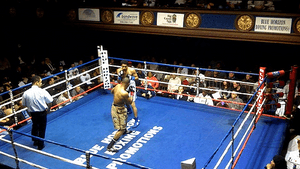Stay in the Loop
BSR publishes on a weekly schedule, with an email newsletter every Wednesday and Thursday morning. There’s no paywall, and subscribing is always free.
I’ve been watching Ray Donovan, a Showtime series that sets a lot of scenes inside a family-owned boxing gym in Los Angeles. (It’s been running four years, but I’m on season two.) It’s a good show, but not so good it keeps my attention from the fight posters on the gym’s walls.
The posters look real. They are the right size, the right red and black print, the right yellow (seemingly) heavy cardboard, fit for tacking to telephone polls or standing in store windows to promote the card. Like boxing itself, they’re solid but tacky.
Quintessential Philadelphia boxer
I haven’t been a fight fan for years, and I don’t know most of the fighters’s names. But one jumps out at me: Bennie Briscoe. I’d already seen Bad Bennie fight three or four times when I left Philly in September 1967. He lasted 20 years (66-24-5, with 53 KOs.), and beat some past or future world champions without becoming one. Wikipedia calls him “the quintessential Philadelphia boxer.” Ring ranks him number 34 of “the 100 greatest punchers of all time.”
I spotted Briscoe’s name on two posters. On one, his opponent is a fellow named Vinales. The other is named Elliott Miller, and the fight is at the Legendary Blue Horizon, on North Broad St. (I was there once, but I don’t remember who was beating whom.)
Vinales could be a fighter’s name, I thought. But Elliott Miller? It sounded Jewish more than anything, and in the 1960s and ‘70s, what were the chances of that? It wasn’t even “Elliott ‘the Oxford Circle Assassin’ Miller” to boost the gate.
Looking for clues
It was an itch I had to scratch. Luckily, I knew how. I went to John DiSanto’s invaluable website phillyboxinghistory.com. I clicked my way to Bennie Briscoe’s record. There was Luis Vinales, twice. He decisioned Briscoe in Scranton, at the Catholic Youth Center, in April, 1972. Four months later, Briscoe KO’d him in seven rounds.
But no Elliott Miller, win, lose, or draw.
I had too much faith in John DiSanto to believe he’d left a hole in Briscoe’s past. My theory: Elliott Miller was a pal of Ray Donovan’s producer, and the producer slipped Miller’s name onto a poster as a gag. I needed confirmation and emailed DiSanto. I said I’d been watching Ray Donovan.
He replied immediately. He was also a Ray Donovan fan. The posters were mostly real. The show acquired them from the collection of Philly fight promoter J. Russell Peltz. Elliott had pulled out of a fight with Briscoe at the last minute, too late for new posters. “Neil Edwards stepped in on 1/12/71.”
So there it was. Without the internet I would have lived in ignorance or been driven screaming mad. Further research revealed Elliott went 11-6-4, a “tomato can,” in the parlance of the trade, a bleeder with poor skills. If Elliott was been a minor garnishment on Briscoe’s menu, Neil Edwards seemed less. He had no record anywhere.
From walls to windows
But what had drawn my attention away from Ray Donovan’s cavalcade of hurts and betrayals, infidelities and murders, to those walls?
Seeing Bennie Briscoe’s name had led me reflexively to the night in December, 1966, when he beat George Benton so badly “the champ of North Philadelphia” didn’t come out for round 10. Outside, on a cold Market St. sidewalk, a man behind me said, “Ain’t no George Benton no more.”
That rung bell echoed within me still. And that led to the friend with whom I’d attended the fight, then to his suicide in 1976, then to our meeting at a comic book stand in 1952, followed by an Ahmad Jamal concert in 1958, the Alameda flea market trip in 1970 — out of which I got my first published story — and then a Tijuana bar in 1963.
Our past is much of our present. Our memories are much of us. It almost seems that if you revisit the past often enough and if you probe it hard enough, you can make alternatives happen. The twists and turns of those revived dramas are more compelling than any teleplay.
What, When, Where
Ray Donovan. Created by Ann Biderman. Showtime, Sundays at 9 pm ET.
Sign up for our newsletter
All of the week's new articles, all in one place. Sign up for the free weekly BSR newsletters, and don't miss a conversation.

 Bob Levin
Bob Levin
